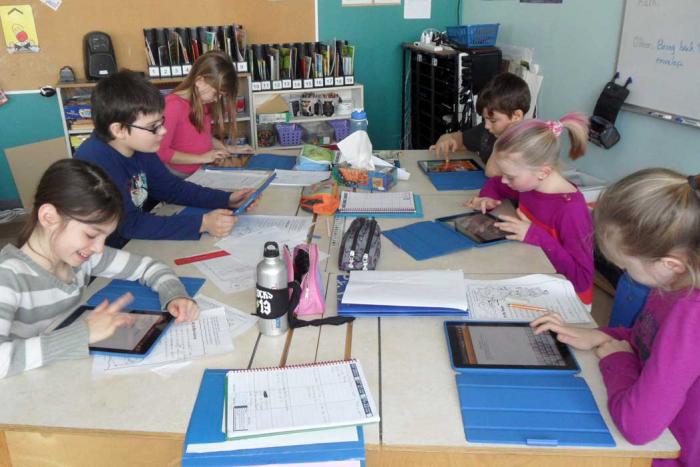Smartphone (personal electronic device)
Organizations: Baie-Comeau High School, Drummondville Elementary School
Coordinates: http://bchsblog.wordpress.com/ and http://drummondville.etsb.qc.ca/
Addresses: Baie-Comeau High School, 39 Av Marquette, Baie-Comeau QC, G4Z 1K4; Drummondville Elementary School, 1050, rue Chabanel, Drummondville, QC J2B 2J5
Regions: North Shore & Lower North Shore; Quebec City Region
Contacts: Baie-Comeau HS, 418-296-2832; Drummondville ES, 819-474-8563
Description: Personal electronic devices are ubiquitous, especially among the younger generation. Students at the Baie-Comeau High School display their cell phones (with teacher Stephen Kohner), and students at the Drummondville Elementary School demonstrate their tablet computers.
Year made: 2007-2012
Made by: Multiple manufacturers
Materials/Medium: Aluminium, glass, plastic, stainless steel
Colours: Various
Provenance: Many sources
Size: varied
Photos: Rachel Garber (Baie-Comeau), Carole A. Hodak (Drummondville)
Wireless World, Wireless Quebec
Jessica Grosman
When Apple’s online “App” store opened in 2008, Edovia released Linguo, an iPhone app that included a translator and a phrasebook in 25 languages. Perhaps Edovia’s unique position as a Montreal-based company designing apps for a mass market inspired the translator app. Two years later, the company created Warships, a free game that was downloaded one million times in 53 days. The small Montreal-based company tapped into an exploding global consumer market.
Over the 20th and now into the 21st centuries, Quebec and Canada have used communications and technology to find their place in North America and the world. In the early 20th century another new technology, wireless telephony, better known as radio, forced the Canadian and Quebec governments to ponder whether American popular culture would consume Canadian identity.
The Marconi Company broadcast the first radio signal from Montreal in 1919. Yet, Canadian companies did not have the means or audience to really take advantage of the new media. By the 1930s American networks dominated the airwaves; radio had opened Canada’s borders to American culture. The Canadian government hoped that Canada could establish its own network, uniting the nation from coast to coast and preventing American cultural domination. This hope (and worry) created the Canadian Broadcasting Corporation (CBC) in 1936 and Radio-Canada in 1937. The government decided that the Canadian people owned the airwaves so broadcasters had to serve the public interest.
In Quebec the provincial government wanted the province to control its broadcasting system. Quebec’s private radio industry was more local and vibrant than its Canadian counterpart. The French language acted as a protective barrier against American broadcasting. Locally produced programs, especially variety shows and radio dramas, were very popular in the province. Radio reinforced the rivalry between two linguistic communities while it opened up new opportunities to communicate across distances.
In 1960 the Mayor of Montreal, Jean Drapeau, capitalized on Quebec’s unique position at the edge of the North American market. Drapeau expected that Montreal’s proximity to American media companies would spur economic growth while strengthening Quebec culture; he created the Cité des ondes—a place for media and technology--in Montreal’s East End. The mayor’s project made Montreal and Quebec modern, connected and creative. In recent years, the Quebec government has fostered the video game and multimedia industry through financial incentives.
Quebec still negotiates the relationship between technology and society; it’s a balance between local and global. Learning to use new technology is an experience that every Quebecer shares. In 2003, the Eastern Townships School Board launched the first large-scale “one laptop per child” program in Canada. Similar programs exist in the United States, Latin America and Africa. The program ensured that every student from Grade 3 to Secondary V (grade 11) had access to a laptop or tablet. Studies determined that when computers entered the classroom, the students became motivated to work on school projects and they researched and interacted more in class. The dropout rate plummeted 16% in two years.
Technology has changed Quebec’s place in the world and opened new opportunities at home. Mobile technology-- and its use by youth in particular--is not simply about the newest gadget or latest trend but a truly deep sociological phenomenon with historical precedents. It’s about how we communicate despite obstacles and find new ways to represent our place in the world.
Sources
Annick Germain and Rose Damaris, Montréal: The Quest for a Metropolis, 2000.
Thierry Karsenti and Simon Collin. “Highlights Phase I.” Benefits and challenges of using laptops in primary and secondary school: An investigation at the Eastern Township School Board. http://etsb.karsenti.ca
Nicolas Van Praet. “Video game tax break makes Quebec an industry hub.” Financial Post, 15 October 2012.
Marc Raboy. Missed Opportunities: The Story of Canada’s Broadcasting Policy (Montreal: McGill-Queen’s University Press, 1990).
“iPhone Developer Edovia Gets 1,000,000 Downloads of Warships.” Next Montreal, 20 August 2010. http://nextmontreal.com/2010/08/20/iphone-developer-edovia-warships-success
To Learn More
Mary Vipond. The Mass Media in Canada: Fourth Edition, 2011.
Lee Rainie. Networked: The New Social Operating System, 2012.
Lisa Gitelman. Always, Already New, 2008.
Author
Jessica Grosman is writing her MA history thesis about how pulp and paper workers in the Saguenay region leveraged the media during labour conflicts. Jessica was raised in Pointe-Fortune, Quebec, and now calls Montreal home.









